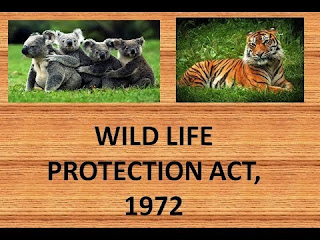INTRODUCTION:
The Government of India enacted Wildlife Protection Act, 1972 with the objective of effectively protecting the wildlife of this country. And further to control Poaching, Smuggling and illegal trade in wildlife and its derivative. It consists of 60 sections and VI schedules that are divided into eight chapters. It came into force on 9th September, 1972.
DEFINITIONS:
Generally, wildlife means, it implies to all the biotic elements on the earth including all the species of animals, plants, birds and microbes of the world excluding man, domestic animals and the cultivated plants. It is the umbrella legislation for the wildlife conservation in India. In this act, two amendments were made in 1991 and 2003.
- Definitions under 1972 act – “An act to provide for the protection of wild animals and birds and for matters connected therewith or ancillary and incidental thereto”
- Amended definition in 1991 – “An act to provide for the protection of wild animals, birds and plants and for matters connected therewith or ancillary and incidental thereto”
- Section – 2 of the Wildlife Protection act, 1972 has listed a set of definitions of several terms as used in it. It is decisive to understand these clearly as they are important to correct the implementation of the act.
- Section 2(1) – “Animal” includes mammals, birds, reptiles, amphibians, fish, other chordates and invertebrates and also includes their young and eggs. It is very much important to note here that the young and the eggs of the animals are also treated equally as animal in their own right.
- Section 2(5) – “Captive animal” means any animal, specified in Schedule I, II, III, and IV, which is captured or kept or bred in captivity.
- Section 2(15) – “Habitat” includes land, water or vegetation which is the natural home of any wild animal.
- Section 2(27) – “Specified plant” means any plant specified in Schedule VI.
- Section 2(34) – “Vermin” means any wild animal specified in Schedule V.
- Section 2(36) – “Wild animal” means any animal specified in Schedule I, II, III or IV and found in wild in nature.
- Section 2(37) – “Wild life” includes any animal, aquatic or land vegetation which forms part of any habitat.
FEATURES OF WILDLIFE PROTECTION ACT, 1972:
1. Authorities Constituted –
State Government & Administrators of Union Territories – Wildlife advisory Board.
2. Duties of Wildlife advisory Board – The Board selects the areas to be declared as Sanctuaries, National Parks. It makes the policies formulation for protection and conservation of wildlife and specifies plants. They deal with the matter relating to amendment of any schedules. Measures will be taken for harmonizing the needs of the tribes.
3. Hunting of Wild animals – Capturing, killing, poisoning, trapping of any wild animal, injury, destroy, taking any part of the body, eggs or nests damage, disturb. The act prohibits hunting of any wild animals that are specified.
4. Hunting of Wild animals to be permitted under certain cases – Any wild animals specified, that has become dangerous to human life or is as disabled or diseased as to be beyond recovery and for the purpose of Education and Scientific Research.
5. Protection of Specified Plants
6. Declaration of Sanctuaries, National Parks and Close Areas.
7. Forfeit of Property derived from illegal hunting and trade.
8. Punishments: Imprisonment will be minimum three years and maximum seven years and minimum fine would be Rs. 10,000/- and the maximum fine would be Rs. 25,000/-.
9. There are many amendments made in the act to enforce it more firmly.
SCHEDULES OF THE ACT:
There are Six Schedules in this act which is divided into eight chapters.
- These Schedules gives different standard of protection.
- Species that are listed in Schedule I and part II of Schedule II get absolute protection. Offences under these are prescribed the highest penalties.
- Species that are listed in Schedule III and Schedule IV are also protected, but the penalties are comparatively much lower.
- Schedule V includes the animals which can be hunted.
- The plants mentioned in Schedule VI are prohibited from Cultivation and Planting.
CONSTITUTIONAL PROVISION OF THIS ACT:
In the Constitution of India, Article 48-A explains that, “The State shall Endeavour to protect and improve the environment and to safeguard the forests and wildlife of the country”. This Constitutional provision was inserted through the Constitution Forty Second Amendment Act, 1976.
Article 51-A (g) of Constitution of India imposes certain fundamental duties for the people of India. It States, “It shall be the duty of every citizen of India to protect and improve the natural environment including forests, lakes, rivers and wildlife and to have compassion for the living creatures”.
IMPORTANT NOTE TO THE VIEWERS:
During this Pandemic crisis, I recommend reusable masks. But if and when you use a disposable mask, please dispose of it properly. Why because, the straps entangle and injure the wildlife such as birds and aquatic or marine animals. So when you are done with your mask, Please do cut the straps and dispose of the mask properly. Do your part! Take care of yourself and Take care of the environment!
CONCLUSION:
So, it is our duty and we have to take effort to preserve wild animals from extinction. Some of the species have become extinct due to the natural activities. The advancement of the man throughout has become beneficial for the human beings but it is the wild life that has been suffered a lot through the years. So, here we discussed about the Wildlife Protection act, 1972 and its features, provisions, and schedules. Therefore, let’s take care of our self and take care of our environment!!
“THE CONTINUED EXISTENCE OF WILDLIFE AND WILDERNESS IS IMPORTANT TO THE QUALITY OF LIFE OF HUMANS”.
– Jim Fowler
REFERENCES:
The Wildlife Protection Act, 1972.
Constitutional Law of India – Dr. Pandey
www.helplinelaw.com



Good article 👏
Very informative…
Clearly explained💥✨🔥